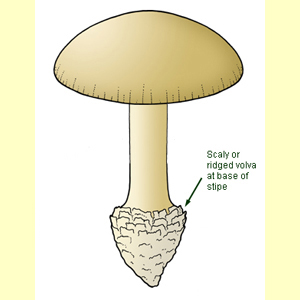
The volva occurs at the base of the stipe, and it is formed from the remnants of a universal veil which may cover the entire fruit-body when young. When the universal veil breaks as the fruit-body expands with maturity, the universal veil can also leave patches of tissue or scales on the pileus surface which are obviously different in texture from the underlying surface. Such patches or scales on the pileus surface can suggest the presence of a volva.
To observe the presence or absence of a volva it is necessary to look carefully at the base of the stipe. Make sure that the stipe base is removed intact from the soil when picking the fruit-body (and the stipe does not break off above the base). A cross section of the stipe base may help in interpreting the structure of the volva.
Choose this state if: there is a volva at the stipe base consisting of one or more rows of scales or ridges, or one or more powdery or membranous zones. When the volva is one or more zones, the powdery or membranous remains are different in texture to the rest of the stipe, and often matched by similar texture on the pileus surface. When a volva is present, the stipe base is often bulbous, and the scales, ridges or zones will often be at the top of or just above the bulb. A circumsessile volva is included in this state; here the volva is membranous and tightly adhering to the surface, with no free rim at the upper edge, although the texture and/or colour of the volva is different to that of the stipe.
If there are several zones on the stipe surface well above the base, choose the option belts of tissue under Stipe surface texture.
